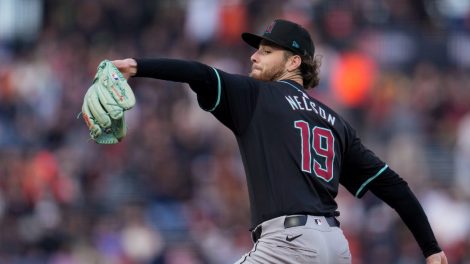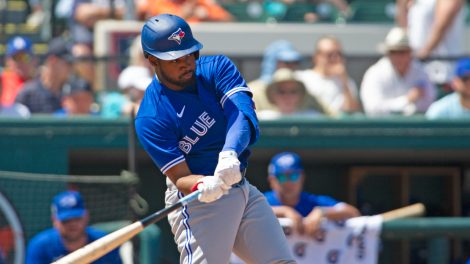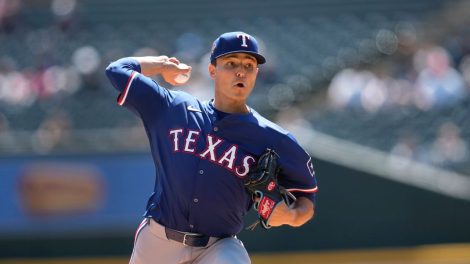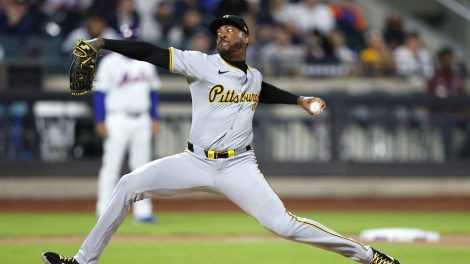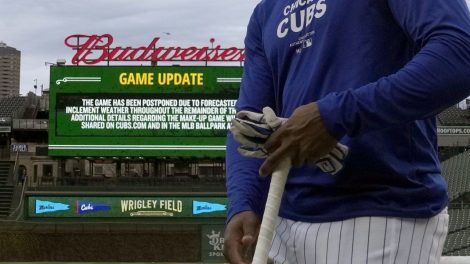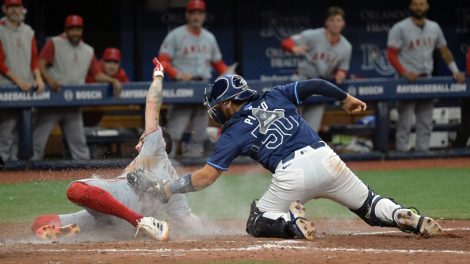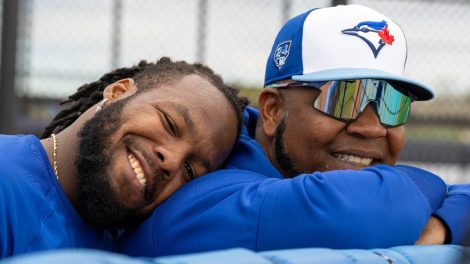TORONTO – Over the past couple of years, Mateos Kekatos reinvented himself as a pitcher with the University of Toronto Varsity Blues. He put in hours upon hours of work to refine his delivery, to better understand his repertoire, to hone the quality of his pitches and the results showed on the mound, with a couple of seasons that positioned him to become the second player ever selected in the June draft out of Ontario University Athletics.
On the cusp of achieving a lifelong dream, the 22-year-old is instead among the thousands of young players left in limbo by the COVID-19 pandemic and Major League Baseball’s decision to run a five-round draft next month as a result.
Canadians eligible this year will be hit particularly hard by the fallout, although the country’s top prospects of the 2020 class – outfielders Owen Caissie of Burlington, Ont., David Calabrese of Maple, Ont., and Jordan Nwogu of Ottawa – may avoid the collateral damage.
Those further down the draft lists, though, are going to be adversely impacted, especially someone like Kekatos, who has already overcome extreme odds in emerging from a rarely travelled pathway.
“It’s not an easy thing. It can be difficult,” says the Toronto-born right-hander. “But as any athlete would experience, you’re going to face adversity, whether it’s in a game or off the field. This is a big one, but it’s not just me being impacted by it. It’s literally everybody else in the sporting world. Everybody’s dealing with it. I’m going to deal with it in my way, and my way has always been to put my nose down to the grinder and work hard.
“And when that next thing comes up, I’m going to be ready for it.”
[snippet id=3305549]
A five-round draft makes it very unlikely a team will select Kekatos, but clubs can sign an unlimited number of free agents for up to $20,000 afterwards and he continues to garner interest.
In theory, that sounds great but it’s unclear how many players passed over will actually get signed, since running the full minor-leagues isn’t going to be possible, eliminating the need for so-called organizational players to fill out rosters.
While some form of expanded Arizona Fall League or larger internal instructional leagues are being contemplated, opportunities are going to be very limited, so teams that load up will have to be creative in how they house incoming players while servicing those already in the system.
In concert with scouting complications due to the lack of a spring season and the financial implications, the expectation is clubs will not be able to buy as many prep-school players out of school, and that the draft will focus on collegians.
“Teams are going to go safe with only five rounds and that hurts Canada,” says Greg Hamilton, Baseball Canada’s director of national teams. “Normally here, the value comes after the fifth round. You’ll have the slam dunkers early, but I always look at it as Canadian value is seventh to 12th round, where you pick up a Michael Saunders (11th round), a Scott Mathieson (17th round), guys that have a really, really projectable upside, but you’re not going to take them in second, third or fourth round.”
Chicago Cubs right-hander Rowan Wick (ninth round, 2010), Jordan Romano (10th round, 2012) and Dalton Pompey (16th round, 2010) are other recent examples. Go a bit further back and Russell Martin (17th round, 2002) and Jason Bay (22nd round, 2000) would have been left on the outside looking in.
[snippet id=4888368]
Another trickle-down effect is that with fewer players entering professional baseball, several college teams will suddenly find themselves over capacity, with more freshmen arriving and fewer juniors departing. Already some high-schoolers are having scholarship offers revoked, and playing time opportunities will become scarcer.
The game will be a mess at multiple levels next year.
For Kekatos, things are a bit more straightforward in that regard.
The pandemic forced him to cancel a slate of private workouts he had scheduled for scouts, but they’ve been in contact since scouting restrictions were lifted and signing as a free agent remains a possibility. If not, as long as he takes a full course load – he’s only a few classes away from a kinesiology degree – he can play one more year with the Blues, although the OUA’s plans for next season won’t be decided before June.
A lot’s riding on the next few weeks.
“I’m going to do everything that I can so whenever I get that opportunity, I’m going to be in the best shape possible for it. That’s my mentality,” says Kekatos. “A lot of what I had been working toward the last few years has been to hear my name called on draft day. Although that is very unlikely now, there are other routes for it and I’m very focused on that.”
[relatedlinks]
The positive frame of mind is a byproduct of his baseball journey, one that started at the country’s pre-eminent university program at the University of British Columbia but after just one season brought him back home to the University of Toronto.
Kekatos had offers to play in the United States out of high school but prioritized his education and felt the UBC program – which has had 24 players selected in the draft, including Jeff Francis ninth overall in 2002 – offered him the best path forward. Though he enjoyed the baseball end of things, he struggled being away from his tight-knit family, especially as they endured some tough times, having issues sleeping and dropping 25 pounds despite maintaining his diet.
Back in Toronto, he played some junior ball with North York where he reconnected with Yusuke Oshima, an assistant coach at U of T who paved the way for his transfer. The Blues won an Ontario title in 2017 with Kekatos as a two-way player, but he wanted to become a bigger part of the team so he began training with the Baseball Development Group in Toronto.
There he trained under John Mariotti and Stephen Osterer with three focuses – movement quality when pitching, a strength program, and mobility training – which helped “everything snowball in a good way.”
“I’d always put in the time and put in effort, but with BDG, it started to really take hold for me, having a concentrated environment for that made all the difference,” says Kekatos. “I was tight in the hips. My shoulders were also tight when I first got there. Opening up those areas was key for me. This off-season, a lot of arm action stuff, really trying to tie the whole system together.”
[snippet id=4722869]
While rebuilding himself, Kekatos also began teaching at BDG and the combination of learning, teaching and doing created a growth cycle that translated on the field. He also began tracking his pitching with Rapsodo data, which taught him how he’d been misusing his repertoire.
Mostly relying on a sinker-curveball combination, he discovered that his low-90s four-seamer had elite spin rates, sitting in the 2,400 range and topping out in the low 2,500s. He paired that with a slider he hadn’t used much since his UBC days while refining a slow low-spin knuckle-curve into a harder offering in the low 70s.
Now he’s got the four-seamer which tends to run left-to-right, a slider that tends to drop and the curve darting right-to-left, all coming out of the same arm slot. Kekatos is also optimistic that he’s found the grip for a reliable change-up that’s long eluded him.
“I used Rapsodo to build up my pitch repertoire from the base I had to what I have now,” he says.
The results had him poised to become the second player to be drafted out of the OUA, joining Brock Badgers infielder Shaun Valeriote, who was taken in the 39th round in 2012 by the Blue Jays. Now, he may follow in the footsteps of Brock right-hander Alex Nolan, who signed as a free agent with the Blue Jays last June.
“Getting picked up by an MLB organization is my dream,” says Kekatos. “There are a lot of guys that are going to go through that as well. There are a lot of guys that are going to be put into even more difficult situations. There are guys that are losing out on a lot of money. Guys that work hard at it just like me.
“Putting it into perspective like that, it’s really been a lot easier for me to put that work in, knowing that there are going to be opportunities there and that there are people that want to see me and want to talk to me further. I’m going to be in the best shape possible for when that time comes around, whenever it is.”


